Zhen Han
Hierarchical Lexical Graph for Enhanced Multi-Hop Retrieval
Jun 09, 2025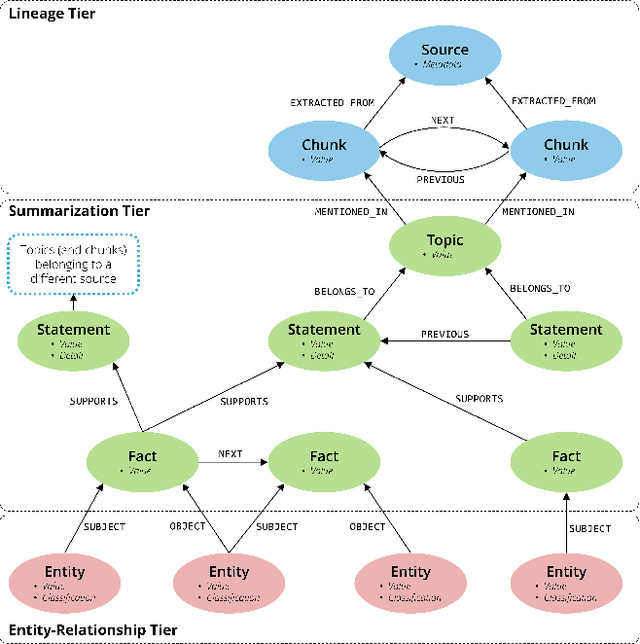



Abstract:Retrieval-Augmented Generation (RAG) grounds large language models in external evidence, yet it still falters when answers must be pieced together across semantically distant documents. We close this gap with the Hierarchical Lexical Graph (HLG), a three-tier index that (i) traces every atomic proposition to its source, (ii) clusters propositions into latent topics, and (iii) links entities and relations to expose cross-document paths. On top of HLG we build two complementary, plug-and-play retrievers: StatementGraphRAG, which performs fine-grained entity-aware beam search over propositions for high-precision factoid questions, and TopicGraphRAG, which selects coarse topics before expanding along entity links to supply broad yet relevant context for exploratory queries. Additionally, existing benchmarks lack the complexity required to rigorously evaluate multi-hop summarization systems, often focusing on single-document queries or limited datasets. To address this, we introduce a synthetic dataset generation pipeline that curates realistic, multi-document question-answer pairs, enabling robust evaluation of multi-hop retrieval systems. Extensive experiments across five datasets demonstrate that our methods outperform naive chunk-based RAG achieving an average relative improvement of 23.1% in retrieval recall and correctness. Open-source Python library is available at https://github.com/awslabs/graphrag-toolkit.
Wan: Open and Advanced Large-Scale Video Generative Models
Mar 26, 2025



Abstract:This report presents Wan, a comprehensive and open suite of video foundation models designed to push the boundaries of video generation. Built upon the mainstream diffusion transformer paradigm, Wan achieves significant advancements in generative capabilities through a series of innovations, including our novel VAE, scalable pre-training strategies, large-scale data curation, and automated evaluation metrics. These contributions collectively enhance the model's performance and versatility. Specifically, Wan is characterized by four key features: Leading Performance: The 14B model of Wan, trained on a vast dataset comprising billions of images and videos, demonstrates the scaling laws of video generation with respect to both data and model size. It consistently outperforms the existing open-source models as well as state-of-the-art commercial solutions across multiple internal and external benchmarks, demonstrating a clear and significant performance superiority. Comprehensiveness: Wan offers two capable models, i.e., 1.3B and 14B parameters, for efficiency and effectiveness respectively. It also covers multiple downstream applications, including image-to-video, instruction-guided video editing, and personal video generation, encompassing up to eight tasks. Consumer-Grade Efficiency: The 1.3B model demonstrates exceptional resource efficiency, requiring only 8.19 GB VRAM, making it compatible with a wide range of consumer-grade GPUs. Openness: We open-source the entire series of Wan, including source code and all models, with the goal of fostering the growth of the video generation community. This openness seeks to significantly expand the creative possibilities of video production in the industry and provide academia with high-quality video foundation models. All the code and models are available at https://github.com/Wan-Video/Wan2.1.
ICE-Bench: A Unified and Comprehensive Benchmark for Image Creating and Editing
Mar 18, 2025Abstract:Image generation has witnessed significant advancements in the past few years. However, evaluating the performance of image generation models remains a formidable challenge. In this paper, we propose ICE-Bench, a unified and comprehensive benchmark designed to rigorously assess image generation models. Its comprehensiveness could be summarized in the following key features: (1) Coarse-to-Fine Tasks: We systematically deconstruct image generation into four task categories: No-ref/Ref Image Creating/Editing, based on the presence or absence of source images and reference images. And further decompose them into 31 fine-grained tasks covering a broad spectrum of image generation requirements, culminating in a comprehensive benchmark. (2) Multi-dimensional Metrics: The evaluation framework assesses image generation capabilities across 6 dimensions: aesthetic quality, imaging quality, prompt following, source consistency, reference consistency, and controllability. 11 metrics are introduced to support the multi-dimensional evaluation. Notably, we introduce VLLM-QA, an innovative metric designed to assess the success of image editing by leveraging large models. (3) Hybrid Data: The data comes from real scenes and virtual generation, which effectively improves data diversity and alleviates the bias problem in model evaluation. Through ICE-Bench, we conduct a thorough analysis of existing generation models, revealing both the challenging nature of our benchmark and the gap between current model capabilities and real-world generation requirements. To foster further advancements in the field, we will open-source ICE-Bench, including its dataset, evaluation code, and models, thereby providing a valuable resource for the research community.
VACE: All-in-One Video Creation and Editing
Mar 11, 2025Abstract:Diffusion Transformer has demonstrated powerful capability and scalability in generating high-quality images and videos. Further pursuing the unification of generation and editing tasks has yielded significant progress in the domain of image content creation. However, due to the intrinsic demands for consistency across both temporal and spatial dynamics, achieving a unified approach for video synthesis remains challenging. We introduce VACE, which enables users to perform Video tasks within an All-in-one framework for Creation and Editing. These tasks include reference-to-video generation, video-to-video editing, and masked video-to-video editing. Specifically, we effectively integrate the requirements of various tasks by organizing video task inputs, such as editing, reference, and masking, into a unified interface referred to as the Video Condition Unit (VCU). Furthermore, by utilizing a Context Adapter structure, we inject different task concepts into the model using formalized representations of temporal and spatial dimensions, allowing it to handle arbitrary video synthesis tasks flexibly. Extensive experiments demonstrate that the unified model of VACE achieves performance on par with task-specific models across various subtasks. Simultaneously, it enables diverse applications through versatile task combinations. Project page: https://ali-vilab.github.io/VACE-Page/.
ACE++: Instruction-Based Image Creation and Editing via Context-Aware Content Filling
Jan 07, 2025



Abstract:We report ACE++, an instruction-based diffusion framework that tackles various image generation and editing tasks. Inspired by the input format for the inpainting task proposed by FLUX.1-Fill-dev, we improve the Long-context Condition Unit (LCU) introduced in ACE and extend this input paradigm to any editing and generation tasks. To take full advantage of image generative priors, we develop a two-stage training scheme to minimize the efforts of finetuning powerful text-to-image diffusion models like FLUX.1-dev. In the first stage, we pre-train the model using task data with the 0-ref tasks from the text-to-image model. There are many models in the community based on the post-training of text-to-image foundational models that meet this training paradigm of the first stage. For example, FLUX.1-Fill-dev deals primarily with painting tasks and can be used as an initialization to accelerate the training process. In the second stage, we finetune the above model to support the general instructions using all tasks defined in ACE. To promote the widespread application of ACE++ in different scenarios, we provide a comprehensive set of models that cover both full finetuning and lightweight finetuning, while considering general applicability and applicability in vertical scenarios. The qualitative analysis showcases the superiority of ACE++ in terms of generating image quality and prompt following ability. Code and models will be available on the project page: https://ali-vilab. github.io/ACE_plus_page/.
HybGRAG: Hybrid Retrieval-Augmented Generation on Textual and Relational Knowledge Bases
Dec 20, 2024



Abstract:Given a semi-structured knowledge base (SKB), where text documents are interconnected by relations, how can we effectively retrieve relevant information to answer user questions? Retrieval-Augmented Generation (RAG) retrieves documents to assist large language models (LLMs) in question answering; while Graph RAG (GRAG) uses structured knowledge bases as its knowledge source. However, many questions require both textual and relational information from SKB - referred to as "hybrid" questions - which complicates the retrieval process and underscores the need for a hybrid retrieval method that leverages both information. In this paper, through our empirical analysis, we identify key insights that show why existing methods may struggle with hybrid question answering (HQA) over SKB. Based on these insights, we propose HybGRAG for HQA consisting of a retriever bank and a critic module, with the following advantages: (1) Agentic, it automatically refines the output by incorporating feedback from the critic module, (2) Adaptive, it solves hybrid questions requiring both textual and relational information with the retriever bank, (3) Interpretable, it justifies decision making with intuitive refinement path, and (4) Effective, it surpasses all baselines on HQA benchmarks. In experiments on the STaRK benchmark, HybGRAG achieves significant performance gains, with an average relative improvement in Hit@1 of 51%.
PERFT: Parameter-Efficient Routed Fine-Tuning for Mixture-of-Expert Model
Nov 12, 2024
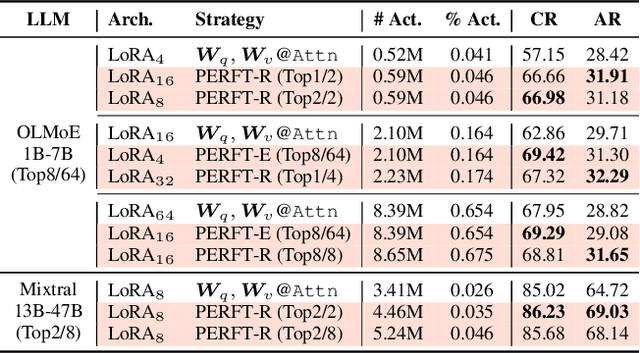

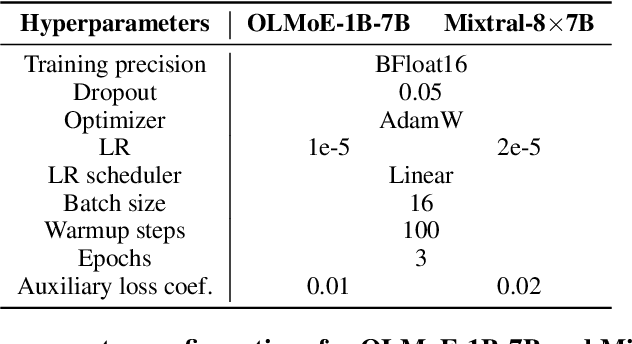
Abstract:The Mixture-of-Experts (MoE) paradigm has emerged as a powerful approach for scaling transformers with improved resource utilization. However, efficiently fine-tuning MoE models remains largely underexplored. Inspired by recent works on Parameter-Efficient Fine-Tuning (PEFT), we present a unified framework for integrating PEFT modules directly into the MoE mechanism. Aligning with the core principles and architecture of MoE, our framework encompasses a set of design dimensions including various functional and composition strategies. By combining design choices within our framework, we introduce Parameter-Efficient Routed Fine-Tuning (PERFT) as a flexible and scalable family of PEFT strategies tailored for MoE models. Extensive experiments on adapting OLMoE-1B-7B and Mixtral-8$\times$7B for commonsense and arithmetic reasoning tasks demonstrate the effectiveness, scalability, and intriguing dynamics of PERFT. Additionally, we provide empirical findings for each specific design choice to facilitate better application of MoE and PEFT.
Visual Question Decomposition on Multimodal Large Language Models
Sep 28, 2024



Abstract:Question decomposition has emerged as an effective strategy for prompting Large Language Models (LLMs) to answer complex questions. However, while existing methods primarily focus on unimodal language models, the question decomposition capability of Multimodal Large Language Models (MLLMs) has yet to be explored. To this end, this paper explores visual question decomposition on MLLMs. Specifically, we introduce a systematic evaluation framework including a dataset and several evaluation criteria to assess the quality of the decomposed sub-questions, revealing that existing MLLMs struggle to produce high-quality sub-questions. To address this limitation, we propose a specific finetuning dataset, DecoVQA+, for enhancing the model's question decomposition capability. Aiming at enabling models to perform appropriate selective decomposition, we propose an efficient finetuning pipeline. The finetuning pipeline consists of our proposed dataset and a training objective for selective decomposition. Finetuned MLLMs demonstrate significant improvements in the quality of sub-questions and the policy of selective question decomposition. Additionally, the models also achieve higher accuracy with selective decomposition on VQA benchmark datasets.
WebPilot: A Versatile and Autonomous Multi-Agent System for Web Task Execution with Strategic Exploration
Aug 28, 2024



Abstract:LLM-based autonomous agents often fail to execute complex web tasks that require dynamic interaction due to the inherent uncertainty and complexity of these environments. Existing LLM-based web agents typically rely on rigid, expert-designed policies specific to certain states and actions, which lack the flexibility and generalizability needed to adapt to unseen tasks. In contrast, humans excel by exploring unknowns, continuously adapting strategies, and resolving ambiguities through exploration. To emulate human-like adaptability, web agents need strategic exploration and complex decision-making. Monte Carlo Tree Search (MCTS) is well-suited for this, but classical MCTS struggles with vast action spaces, unpredictable state transitions, and incomplete information in web tasks. In light of this, we develop WebPilot, a multi-agent system with a dual optimization strategy that improves MCTS to better handle complex web environments. Specifically, the Global Optimization phase involves generating a high-level plan by breaking down tasks into manageable subtasks and continuously refining this plan, thereby focusing the search process and mitigating the challenges posed by vast action spaces in classical MCTS. Subsequently, the Local Optimization phase executes each subtask using a tailored MCTS designed for complex environments, effectively addressing uncertainties and managing incomplete information. Experimental results on WebArena and MiniWoB++ demonstrate the effectiveness of WebPilot. Notably, on WebArena, WebPilot achieves SOTA performance with GPT-4, achieving a 93% relative increase in success rate over the concurrent tree search-based method. WebPilot marks a significant advancement in general autonomous agent capabilities, paving the way for more advanced and reliable decision-making in practical environments.
IDRetracor: Towards Visual Forensics Against Malicious Face Swapping
Aug 13, 2024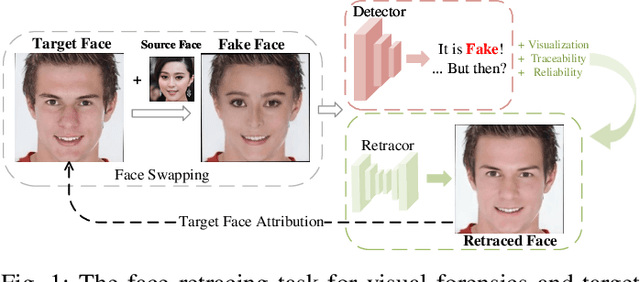
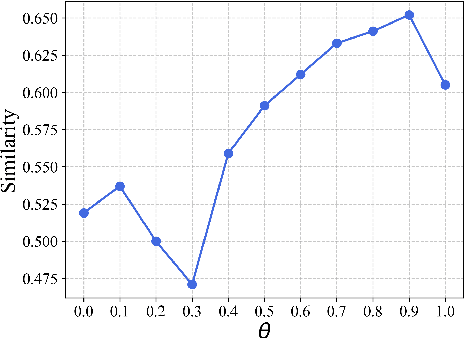
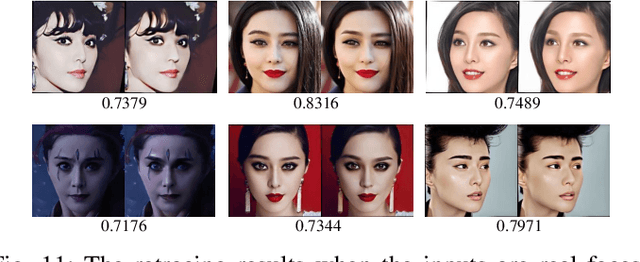
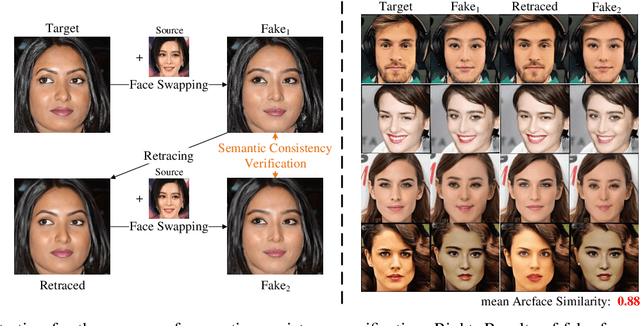
Abstract:The face swapping technique based on deepfake methods poses significant social risks to personal identity security. While numerous deepfake detection methods have been proposed as countermeasures against malicious face swapping, they can only output binary labels (Fake/Real) for distinguishing fake content without reliable and traceable evidence. To achieve visual forensics and target face attribution, we propose a novel task named face retracing, which considers retracing the original target face from the given fake one via inverse mapping. Toward this goal, we propose an IDRetracor that can retrace arbitrary original target identities from fake faces generated by multiple face swapping methods. Specifically, we first adopt a mapping resolver to perceive the possible solution space of the original target face for the inverse mappings. Then, we propose mapping-aware convolutions to retrace the original target face from the fake one. Such convolutions contain multiple kernels that can be combined under the control of the mapping resolver to tackle different face swapping mappings dynamically. Extensive experiments demonstrate that the IDRetracor exhibits promising retracing performance from both quantitative and qualitative perspectives.
 Add to Chrome
Add to Chrome Add to Firefox
Add to Firefox Add to Edge
Add to Edge